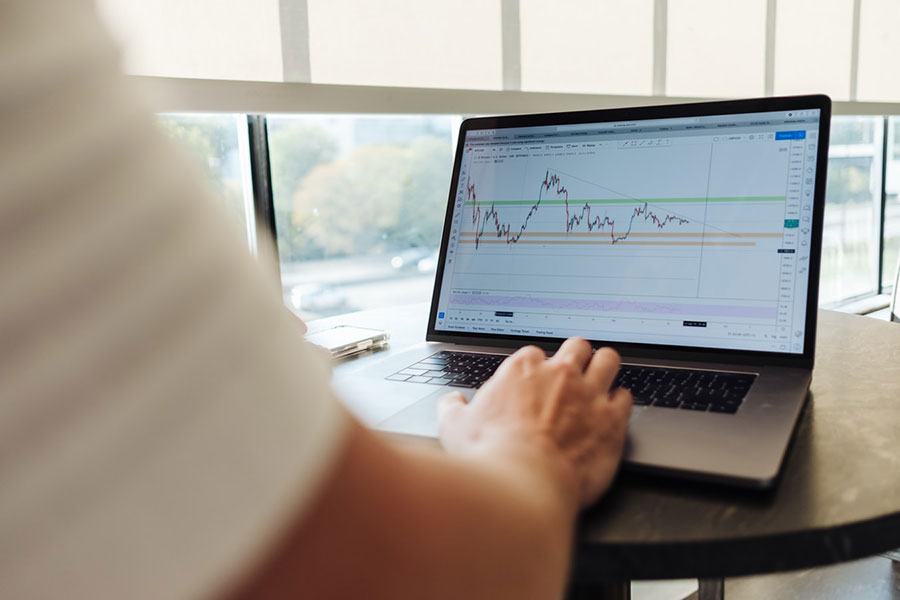Having your own business is not just about a brilliant idea. It is also about determination, time, energy, hard work, and finances. You have probably heard all about investors, but it may surprise you to learn that getting one is not always so simple. People do not come so generously and invest in all the ideas they see.
The various startup funding stages have changed the business landscape. Some years ago, there were not many fundraising options, but recently, there has been a wave of funding available in different stages. As a startup owner, you need to be aware of them and understand how much capital you can get from any external sources.
Now, it is time to get real about where you are heading to fund your startup and how you are going to get it. Learn below more about this topic in this article created by our team at TMS.
How startup funding stages work
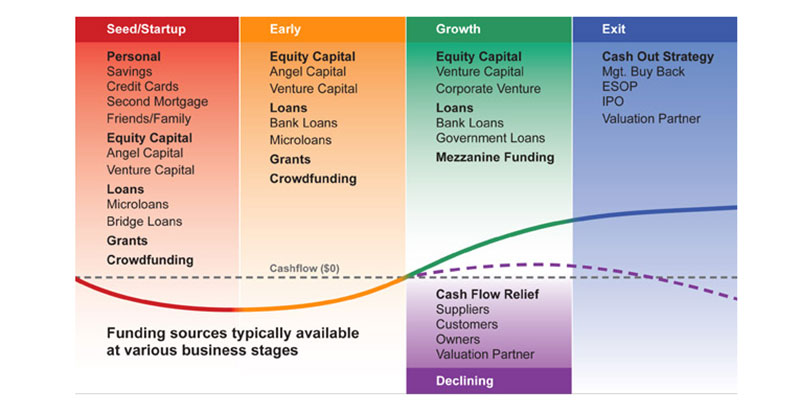
To understand how funding stages work, we must first identify who is involved in the process. The most apparent individuals are those who want to gain funding for their companies. Because the business becomes increasingly mature, it also tends to go through the funding rounds.
Usually, a company is going to start with a seed round and then continue with A, B, and C funding rounds.
Each of the startup funding stages helps entrepreneurs and their businesses to raise enough capital to reach the next milestone or step. This process usually takes 12 months, but there are cases when entrepreneurs can push it to just six months.
In each round, entrepreneurs are wanting to trade equity in their company to get capital so they can level up. Convertible notes are commonly used, especially when investors face risk if founders need to do a bridge round through which they get to the financing round.
Usually, startup funding stages are noted down using alphabets depending on the development stage they are at. Series like A, B, C, etc., are going to be seen a lot. Even though there is no universal plan on what amount represents each stage, the idea behind it is to get higher investments when you move ahead.
The Pre-seed Funding Stage
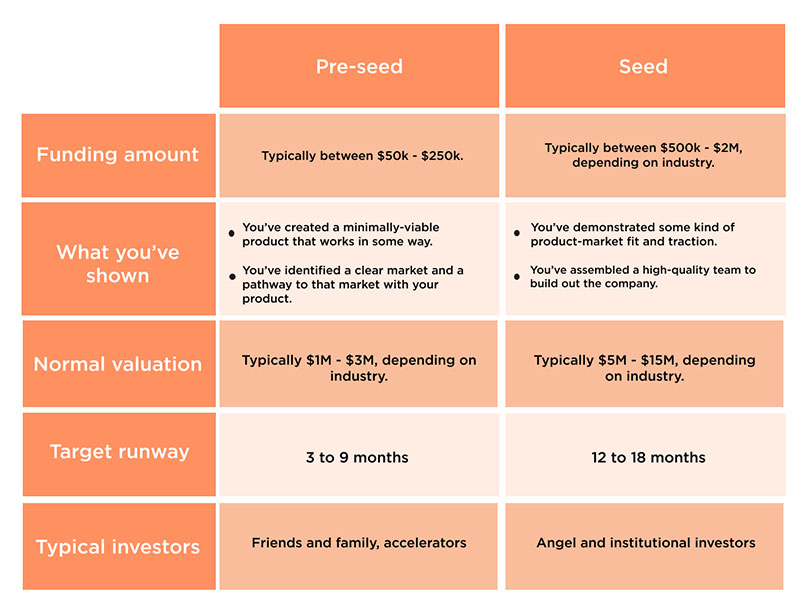
This is the earliest funding stage and is sometimes not even considered a startup funding. The pre-seed funding stage, in general, refers to the time when a startup is just starting its operations.
This startup stage refers a lot to the research or testing the viability of an idea. Here, entrepreneurs usually check if somebody has done this before, determine what are the costs, formulate a business model that they can act on, and grow their idea in business.
Most of the time, investors do not invest in exchange for equity in the startup during this pre-seed stage. Usually, it takes a long time to do it, but it depends on the nature of the startup and the initial costs that need to be considered when developing the business model.
In this pre-seed stage, founders are going to focus on these two steps:
- All early-stage venture capitalists and similar types of investors are going to want to see examples, prototypes, mock-ups, and details about the business and products.
- Potential investors need the proof of concept; they need to see that people actually want to buy into your idea, use your app, or otherwise engage with your company in a way that might lead to profits
Seed Funding Stage
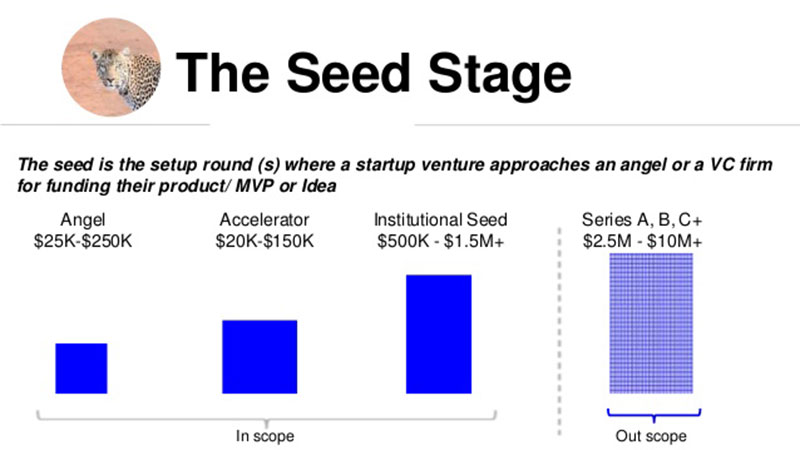
Do not confuse the seed stage with the pre-seed stage, as they are, in fact, totally different stages. Here you already have a product or service, some traction amongst desired demographic, and you have worked out the main direction of your business. Even though the idea is still immature, you do have a name, a brand, and the start of a personality. Most of your funding is again coming friends or family, crowdfunding, or incubator.
As the investors are taking a significant risk by investing in the business, startups need to provide them equity against seed funding. The stakes are quite high because startups cannot guarantee a successful business model.
During it, founders need to be focused on orienting the company to the marketplace. Together with that, they also need to understand their users and what feels natural to them.
Series A Funding Stage
The startup funding stage is the one that people imagine as being the start of funding. Your idea is starting to be a viable business, and it gets more and more attention. At this point, the company already has a running prototype.
Besides tech or science ventures, many companies are in the full operational stage. They usually search for funding from a VC firm or even a consortium of VC firms. The amount is going to be larger than the seed round, and it is going to be offered in exchange for a part of the business. This is why it becomes one of the most challenging parts.
In the Series A period, entrepreneurs work with venture capital firms or angel investors to improve their concepts, bring more team members, find partners, or decrease their burn rate. It is time to set yourself up for future growth and success.
As the business progresses, entrepreneurs should also keep in mind the possibility of strategic partnerships or acquisition opportunities to further accelerate growth and maximize value. Planning ahead and considering when to sell your business can be a crucial strategic decision for long-term success.
How much money is involved in a Series A funding round?
As the investment is higher than the seed round here, we get from $1 million to $15 million. Investors need more substance to do the funding.
Series B Funding Stage
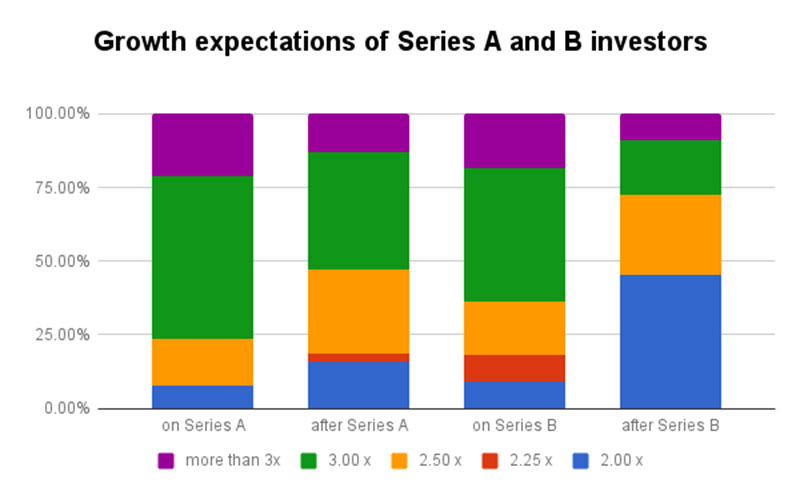 Continuing along with startup funding stages, we will now discuss Series B. This is when a startup has a product that is operational but needs enough capital to bring the product to a broader market. Money is also required for growing a team and bulking up on business development.
Continuing along with startup funding stages, we will now discuss Series B. This is when a startup has a product that is operational but needs enough capital to bring the product to a broader market. Money is also required for growing a team and bulking up on business development.
What happens after Series B round is raised is not just about having more customers, but also increasing the team so that the company can expand. Any ambitious startups need to have great people for their roles. It is no longer possible for the founder to do all the parts, so having money for competitive salaries is going to be necessary.
How much money is involved in a Series B funding round?
The Series B round starts from $7 million and goes to $12 million. Companies should expect a valuation between $25 million and $65 million.
Series C Funding Stage
Any business that reaches the Series C funding stage is considered to be quite successful. Speed and growth are essential here. In series C, companies usually make sine sort of significant change. They might take what they were doing in series B toward international markets or focus on bringing more products for different platforms. Sometimes, they even look for merger options in this stage.
Series C companies want to get their product out of their home country and want to reach the international market. They may also want to increase their valuation before they go for an Initial Public Offering or acquisition.
How much money is involved in a Series C funding round?
For Series C, companies raise an average of $25 million. The valuation of startup funding stages like Series C goes between $100 million and $ 125 million. Sometimes this can be even more special when we think about the explosion of “unicorn” startups.
Series D Funding Stage and Beyond
After Series C, there is no limit to what investment rounds are going to take place for a startup. Some go on to raise investment through Series D, E, and more.
The truth is that many startups do not make it to this stage. The amount raised also varies a lot because it depends on the particularities of the case.
Commonly, a company is going to end its external equity funding with Series C. Even so; companies can go to Series D and Series E rounds of funding as well. For the most part, companies are gaining hundreds of millions of dollars in funding in the Series C rounds.
The startups that go beyond Series C do so because they want a final push before an IPO or if they have not achieved the goals that they set to do in the previous startup funding stages.
How much money is involved in Series D funding or more?
The average amount here is about $50 million and generally speaking, a company valuation can reach $100 – $200 million.
Initial Public Offering (IPO)
When a startup raises funds from the public by selling its shares, the process is called an IPO. In the startup world, this is known as going public. This means the general public now wants to invest in the company by buying its shares.
All investors that traded their money for equity have a chance of getting back their investment, as well as some profit. Some investors can retain their shares, but most of the time, they sell their stock at the beginning to get rewards.
The IPO’s opening stock price is usually set together with the help of an investment banker. There are more details about this, but we have now gone over the basics to help get you started.
FAQs about startup funding stages
1. What are the different stages of startup funding?
The seed stage, Series A, Series B, Series C, and so on are common stages of startup fundraising. Every step entails obtaining money to support development and expansion, with bigger funding rounds as the business expands.
2. How much funding should I seek at each stage of my startup’s growth?
Depending on the demands and objectives of the firm, the required amount of investment may vary, but in general, seed capital is normally between $50,000 and $2 million, series A funding can range from $2 million to $15 million, series B funding can be between $10 million and $50 million, and so on.
3. What is seed funding, and how does it differ from other stages of funding?
The first round of investment a firm receives is known as seed funding, and it is often provided by friends, family, or angel investors.
The money is used to create a prototype or minimum viable product (MVP) and launch the company. Compared to later rounds, seed capital is typically smaller and more speculative.
4. At what stage should I seek venture capital funding?
Often commencing with Series A funding, venture capital funding is sought out in the later phases of a startup’s growth.
Investors in venture capital need to see that a startup has established market traction and growth potential.
5. What is a Series A funding round, and how much capital should I expect to raise in this round?
A startup’s initial round of institutional funding, often from venture capital firms, is known as a Series A fundraising round.
Between $2 million to $15 million in Series A funding should be anticipated by startups. This money is used to grow the company and penetrate new markets.
6. How do I prepare for a funding pitch to potential investors?
A strong business plan and financial model should be developed, as should a pitch presentation that has been practiced.
Prospective investors should also be researched to understand their investment criteria and interests. Additionally, startups need to be able to communicate their distinct value proposition and competitive edge.
7. What are the typical terms of a convertible note, and how does it work in early-stage funding?
A convertible note is a sort of loan instrument that, at a later time, typically at the next funding round, changes into stock. Early-stage investment frequently uses convertible notes because they enable entrepreneurs to raise money without overvaluing the business.
A convertible note may have different terms, but they usually include an interest rate, maturity date, and conversion discount.
8. When is the best time to start seeking funding for my startup?
The optimal moment to begin looking for finance for a business is when it is obvious that money is needed to create the good or service and advertise it. This typically occurs in the early stages of a company’s development, following the initial concept’s validation and the creation of a business plan.
9. What are the common types of equity financing for startups?
Crowdfunding, angel investing, venture capital, and seed finance are typical forms of equity financing for firms. The choice of equity financing depends on the unique requirements and objectives of the business. Each equity financing option has benefits and drawbacks of its own.
10. How do I determine the valuation of my startup at each funding stage?
Startup valuation is determined by several variables, such as the size of the market, future development potential, level of competition, and the experience and qualifications of the founding team.
Many techniques, such as discounted cash flow analysis, comparable company analysis, and the venture capital method, can be used to assess valuation.
If you enjoyed reading this article on startup funding stages, you should check out this one about Steve Jobs leadership style.
We also wrote about a few related subjects like how to value a startup, IPO process, IPO lockup period, risk assessment matrix, business process modelling, business model innovation, business model vs business plan and accelerator vs incubator.
- What Are Third-Party Cookies and How They Work - April 20, 2024
- How Do Websites Detect Adblock? It’s Quite Simple, Actually - April 14, 2024
- Financial Software Development Companies You Should Know - April 11, 2024






